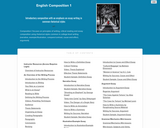WRITING STRONG PARAGRAPHSYou may have noticed that for your Discussion Board and your paper assignments in this class, you are asked to write in well-developed paragraphs. In order to do well on these assignments, then, it helps to know what a strong paragraph is and how to write one.First, a paragraph is a group of closely related sentences, usually anywhere from 5-10, but that depends on what you are writing. A paragraph can exist by itself, in a one paragraph email from your child’s teacher letting you know about your child’s progress in school. Or, a paragraph can be part of a larger document. It might be one paragraph among many in an essay, for example, where you analyze the impact that a change like the growing use of police body cameras might have. Either way, a strong paragraph is organized around a specific point about a topic and that specific point is itself well developed through examples, explanation, analysis, details, research information, among many other writing strategies. Each sentence should be clearly relevant to the main point of the paragraph, connected to the sentences before and after, and help the audience to see or understand the point you are making.Take a look at this paragraph from a student discussion board post that doesn’t do that:My biggest writing problem is that I can’t stay focused when I write. My ideas go all over the place and my grammar is really bad. I have trouble with punctuation and I have never liked reading at all anyway. In high school, I had trouble paying attention in all my English class and I never liked the assignments.Notice that the paragraph at first seems to focus the paragraph on the topic of writing problems and specifically staying focused when writing. The next sentence tries to clarify that idea but then the paragraph loses focus and discusses several other writing issues and problems with paying attention in class and not liking assignments. Those details are not relevant to the main point about staying focused, leaving the reader unsure of why this writer has trouble with staying focused and how this is a problem, for example.Now, compare that sample to this paragraph:My biggest problem with writing is that I tend to lose focus. I will begin to write an essay on a topic and then thousands of ideas will pop into my head and I will want to get them all down on the page. For example, I once wrote a paper in high school on the Electoral College and I found myself throwing in every fact I had found in my research, from what it is, to its origins, to my first experience voting and why I voted for the local sheriff because he was a friend of the family. I didn’t do very well on that paper, turns out, because of this problem. I just find it hard to stick to that one point. I have found that what helps me with this problem is revising because I can always take out things that don’t necessarily belong in the paragraph, but sometimes I also find that it’s hard deciding what is relevant and what needs taking out. Hopefully this class will teach me how to stay more focused.This paragraph does stay focused. It has a clear main point or controlling idea. The example of the high school paper helps to clarify how this problem manifests itself, while the analysis of why this happens is connected to the main point as well.How can you ensure you have a strong paragraph? 1. Always remember that a paragraph needs control and focus. This happens when you establish a main point or topic sentence. The topic sentence establishes not only what the topic is but your point about it. An example would be Students with time management problems can help solve this problem by creating a calendar of things they need to do each week. This sentence identifies a topic (time management problems for students) and the writer’s point about it (this can be solved through a to-do calendar).2. That main point then needs to be demonstrated, explained, developed, and/or clarified. This is where you explore the idea, show the audience what you mean, or prove the point you are making. In a paragraph on time management problems being solved through a calendar, a writer could use personal experience showing how a calendar helped her with class projects; or a writer could include a research study that demonstrated how this technique works for most students.3. The various details within a paragraph need to be connected to each other. Transition or connecting words like “for example” or “also” and “next” help the reader to see the connection between ideas and give your paragraphs a logical flow and organization. PUTTING THIS INTO PRACTICEHere’s an annotated paragraph from an essay that shows you the parts of a successful paragraph. The annotations or comments show how the paragraph succeeds in being unified by a main point, coherently developed through various writing strategies, and connected through appropriate transition words. Juggling the demands of school, work and family can be really challenging for anybody, but if you want to be a successful student, consider creating a calendar with a to-do list. My[JV2] first semester at college was a near disaster. I was adjusting to a new environment, trying to figure out how to carve out enough time in my day to get everything done, and my grades suffered as a result. Thankfully, a friend of mine suggested that I try a calendar, where I identify everything I need to do in my 2 college courses and then prioritize those items and divide my class assignments up throughout the week to ensure I was stay focused and manage everything. The contrast is night and day. For example[JV3] , I now take out my big planner calendar on my desk, look at everything that is due this week in both my classes, chart them out day by day and step by step, and I allot 2 hours each day to complete what I have to get done that day. I know that on Wednesdays I have to complete the reading for both classes and that then on Thursday I need to write and submit my first discussion board post in both classes. This keeps me on track and also gives me a sense of accomplishment. I find my grades are consistently higher now, I have less stress and I find the work far more manageable. It’s changed everything and every student should try[JV4] it.Use this model for writing strong paragraphs, whether in your discussion board or class assignments to help you stay focused and write more organized and better developed paragraphs!WANT MORE HELP WITH WRITING STRONG PARAGRAPHS? Click on this link for more samples and practice with writing paragraphs [JV2]The main point of the paragraph is here developed through personal experience, example, details and analysis, highlighted in blue. The writer contrasts her experience before creating a calendar. She gives an example of how she uses it to make sure she gets all her work done. She also analyzes how this has affected her grades and her outlook as well. If this had been a more formal assignment, she might have included research evidence showing how this strategy improves student grades overall. [JV3]Transition words and phrases like “for example” help to connect the ideas within the paragraph. The paragraph is also organized by time, contrasting the past, negative experience, with the present, more positive and effective experience. [JV4]This concluding sentence, highlighted in purple, briefly concludes the paragraph, summing up the student’s experience and recommending that others try it.






